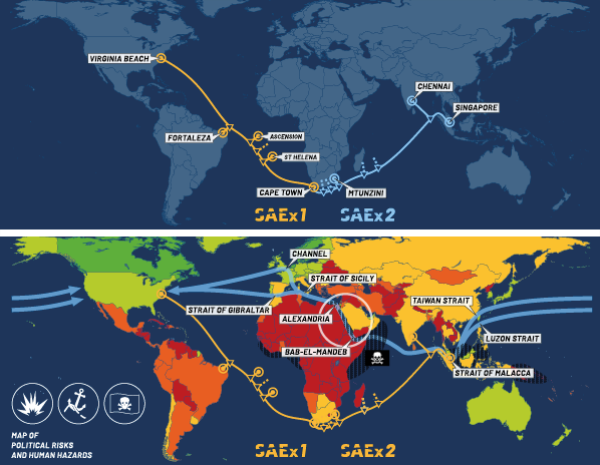08 November 2018

Top: the new project will first cross the Atlantic linking Cape Town to the US via Brazil, and then extend across the Indian Ocean in phase two. Bottom: the cable aims to avoid potentially unstable areas.
Mauritian company South Atlantic Express (SAEx) International is planning to expand its reach to the US East Coast using Sparkle’s pan-American network.
The South African sponsored SAEx cable system is a phased project that will ultimately connect Asia and the Americas, via South Africa.
Under phase one, the SAEx1 system will run initially from Cape Town to a branching unit near to Fortaleza in Brazil where it will interconnect to a partner system providing onward access.
SAEx International has recently announced that it will work with Sparkle, the international services arm of Italy’s TIM Group, to provide connectivity from Brazil and then reaching the US East Coast with landing in New Jersey.
Under the terms of the agreement, Sparkle will also provide interconnection facilities in Brazil as well as technical and sales support in both South and North America.
When SAEx1 becomes ready for service, expected during 1Q21, it will stretch across a total distance of around 14,720km (including branches).
SAEx International says it will feature six fibre pairs with a minimum combined capacity of 72Tbps, and will be the only system connecting South Africa directly to the USA.
The system will then extend east and connect to the Indian Ocean via a second phase.
Over a distance of around 13,900km, SAEx2 will link Cape Town, Singapore and India, with two further fibre pairs between Cape Town and Mtunzini.
It will feature four branching units facing Mtunzini, Mauritius, Madagascar and Chennai in India.
SAEx2 is due to go live in 2Q21.
According to SAEx International, its system will satisfy a number of crucial objectives, including providing strategic diversity for global customers seeking to avoid, to the extent possible, narrow straits and difficult transits through potentially unstable areas or unreliable overland routes.
The company adds that South Africa is “uniquely positioned” at the confluence of two oceans and two hemispheres.
It reckons the SAEx system will “maximise” this locational advantage by offering a “highly valuable and differentiated service” that captures a “significant” portion of East-West data traffic.







